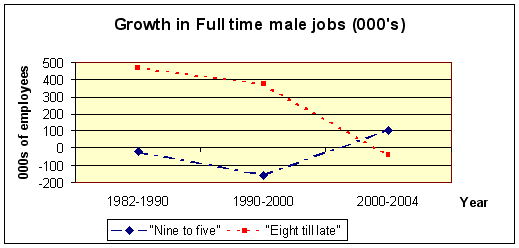Now you’ve heard that line about everyone talking about the weather but no-one doing anything about it. Well, everyone started talking about overwork. But my hunch is that talking about it is doing something about it.
People have become aware that they were playing a mug’s game. They’ve been talking about it, negotiating and starting to look for alternatives. We’re seeing the results.
When I worked in Treasurer John Dawkins’ office in the early 1990s, Treasury Officials worked all hours. Five years ago I'd expect to get someone if I rang their office at 6 pm. Today I usually don’t bother. (One official was always the first to arrive and the last to leave, and from what I could see he did the least work - but I digress.) Today, I’m told plenty of Treasury officers work nine to five.
Advertisement
And now the stats are confirming these anecdotal straws in the wind. In the two decades to 2000, the number of “nine to fiving” men (working between 35 to 44 hours a week) fell by nearly 200,000 whilst the those “eight till lating” (working over 44 hours per week) rose by over 800,000. Since 2000 these figures have been reversed, with over 100,000 more “normal” jobs and 40,000 fewer “overworking” jobs. See table and chart.


What drives all this? If globalisation and deregulation drove working hours up how could more globalisation and deregulation - which is what we’ve had - drive them back down again? If unions have resisted higher working hours, how come they were unsuccessful initially, and now, when they’ve never been weaker, they’ve succeeded.
There are probably lots of explanations, but one of them is that we’re looking at a social contagion and at the beginning of its self-correction.
Discuss in our Forums
See what other readers are saying about this article!
Click here to read & post comments.
1 post so far.